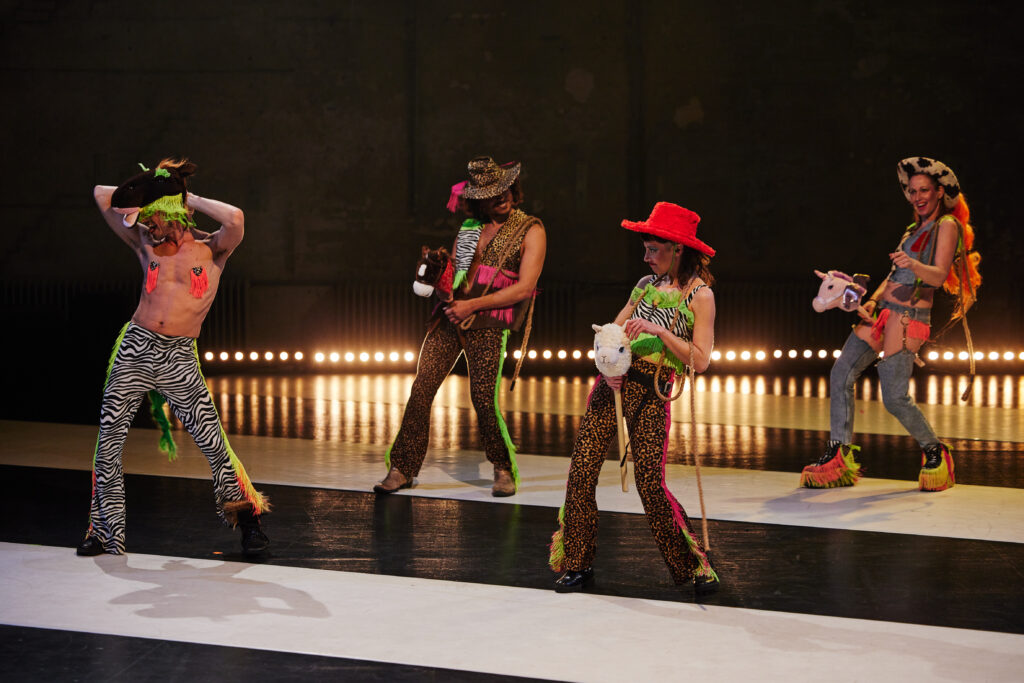photo: Anna Spindelndreier
Anajara Amarante: BUTCHING COWBOYS
Flamboyant and butch queen, crip and queer: Butching Cowboys celebrates a new body norm. Anajara Amarante takes the audience into their queer version of South American surrealism and creates entire dance landscapes out of it. On stage, the performers free themselves from everything that makes them feel out of place – symbols, clothing and doctor’s offices –, and also leave behind learned and imposed behaviors. Closely connected to the artists, the audience experiences a crescendo evening that is both visual protest and ritual celebration. Grief and anger about a society in which a multitude of bodies still find no place become a new way of self-empowerment here.
Anajara Amarante is a chronically ill, queer Brazilian artist. Their main media of work is the moving body. Their professional interests are personal and political: queer, dissident bodies, marginalized communities and art practices. Their main artistic practice is concentrated in the field of performing arts (focus choreography), with previous formations in Biology and Communication. As a Brazilian living in Europe, Anajara is interested in immigrant people, the construction of their identities, and post-colonialism, as well as the construction of joy, inclusion, and diversity. Tis Aly is a queer BIPoC artist with a strong wish for social justice. Tis Aly’s artistic work is a place of collision, meeting the individual and the collective simultaneously. Marc Philipp Gabriel is a Berlin based performance artist working with body, voice, installation, video and architecture from the perspective of dance and movement. SorrySuSu999 is a Berlin based artist with a BA in Anthropology. Their interest goes around performance art to translate their observations about society.
Deutsch
Extravagant und Butch Queen, crip und queer: BUTCHING COWBOYS feiert eine neue Körpernorm. Anajara Amarante nimmt das Publikum mit in eine queere Version des südamerikanischen Surrealismus und lässt daraus ganze Tanzlandschaften entstehen. Auf der Bühne befreien sich die Performer*innen von allem, was sie sich als »Fremdkörper« fühlen lässt – den Symbolen, der Kleidung und den Praxen der Ärzt*innen – und lassen angelernte und erzwungene Verhaltensweise hinter sich. Gemeinsam mit den Künstler*innen erlebt das Publikum einen Crescendo-Abend, der visueller Protest und rituelle Feier zugleich ist. Trauer und Wut über eine Gesellschaft, in der eine Vielzahl von Körpern immer noch keinen Platz finden, werden hier zu einer neuen Form der Selbstermächtigung. Anajara Amarante ist ein*e chronisch kranke*r brasilianische*r, queere*r Künstler*in und beschäftigt sich mit Identitätsbildung, Postkolonialismus sowie der Konstruktion von Freude, Inklusion und Vielfalt.
Konzept | Choreographie | Performance | Bühne Anajara Amarante
Performance | Choreographische Assistenz Tis Aly
Licht- und Bühnendesign | Performance | Video | Produktion Marc Philipp Gabriel
Kostüme | Produktionsassistenz Suzanne Stavast
Premiere: Queering the Crip, Cripping the Queer Festival / Sophiensaele Berlin
16+17+18 SEP 2022
1 + 2 MAR 2024 | 20h | sorry but not sorry festival / Kampnagel Hamburg
photos: Mayra Wallraff / Anna Spindelndreier
Read our FANZINE: Book of Colors
AUDIO Version of the FanZine:
Accessibility information
The audience is arranged in an L-shape on two sides of the stage. The performers often come close to the front row, and in one scene they briefly enter the audience only partially clothed. Straw is used as well as stage fog several times, which is blown directly into parts of the audience. A loud wind machine, animal masks and confetti are also used. In the second scene, a tense atmosphere is created for several minutes. In addition, there are two sudden loud moments. In another scene, the room is almost completely darkened and an uncanny atmosphere is created with frightening voice echoes. Later, a prop is hit several times with a loud bang. In the last scene, loud music, a spinning disco ball, coloured light changes and fog are used simultaneously. The performance is a Relaxed Performance. Relaxed Performances welcome all visitors for whom sitting still for long periods of time in the theatre is a barrier (for example autistic people, people with Tourette’s, learning difficulties or chronic pain). Noises and movements from the audience are welcome. Visitors can leave and return to the auditorium at any time.












